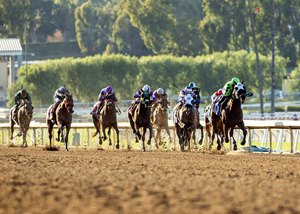Public Expects Racing to Keep Equine Safety a Priority


As ideas were bounced back and forth about different paths forward for racing at last week's Racing and Gaming Conference at Saratoga Springs, N.Y., California Horse Racing Board executive director Scott Chaney reminded everyone that going forward any idea has to include equine safety as a priority.
Chaney offered that assessment after a question from audience member Ken Lowe, chairman of the West Virginia Racing Commission, about the rash of equine racing deaths in 2019 at Santa Anita Park being the impetus for the Horseracing Integrity and Safety Authority.
Chaney, who was not in his current role in California in 2019 but did serve as a steward then, agreed that California's problems served as an impetus of HISA but he said it's important to keep in mind how the public views these problems. The public lumps safety issues into racing's problem—as opposed to the problem of an individual state.
He acknowledged some in the industry viewed California as an embarrassment for the sport when Santa Anita experienced its problems in 2019, but he said it's become very clear that the public didn't limit its concern to the Golden State. He said public reaction to problems at Saratoga Race Course, Churchill Downs, and Laurel Park in recent years suggests this is a concern for the sport overall.
"These days there's no such thing as a hole on your side of the boat," Chaney said.
The good news is that improvements have been made and results have followed, initially in California and then under HISA. Many California ideas, on some level, have been adopted by HISA.
"Certainly from a safety perspective in the past five years our (equine injury) numbers are way down," Chaney said. "We've been trailblazers in terms of safety regulations."
In June, Santa Anita Park reported a 90% reduction in racing fatalities over the past five years, noting efforts on the regulatory side as well as by track owner 1/ST Racing and industry stakeholders.
"It is impossible to overstate the diligence that the entire racing community has put into prioritizing the safety of the horse above all else," said Santa Anita senior vice president and general manager Nate Newby. "From the owners, trainers, jockeys, veterinarians, and the hard-working men and women who care for the horses each day, everyone has done their part to make safety our North Star."
On some level that emphasis has been brought to other HISA racing states. Racetracks operating under HISA's rules that were open for racing reported 0.76 racing-related equine fatalities per 1,000 starts during the second quarter of 2024 as compared to 1.48 racing-related equine fatalities per 1,000 starts during the first quarter of 2023, a decrease of approximately 49% year over year.
Chaney noted that higher equine death numbers in previous decades in California rarely raised an eyebrow, but times have changed. Equine safety has become a public concern and change is not limited to California, as the issue has received the aforementioned national attention.
"We're all in this together," Chaney said. "Racing is a national sport; it's a global sport."
